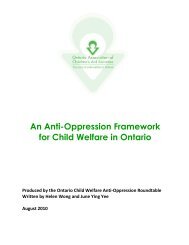English - Ontario Association of Children's Aid Societies
English - Ontario Association of Children's Aid Societies
English - Ontario Association of Children's Aid Societies
Create successful ePaper yourself
Turn your PDF publications into a flip-book with our unique Google optimized e-Paper software.
C. THE INUIT<br />
In 2006, there were 2,035 Inuit living in <strong>Ontario</strong> and outside <strong>of</strong> their land claim<br />
settlement region. According to Statistics Canada, Ottawa-Gatineau has the highest<br />
Inuit population outside <strong>of</strong> Inuit Nunaat (the Inuit homeland), with about 725 Inuit.<br />
There are many reasons behind the growth <strong>of</strong> the Inuit community in Ottawa. As the<br />
nation’s capital, it is a popular city because <strong>of</strong> the employment opportunities<br />
available with the numerous Inuit organizations based in the area and to a lesser<br />
degree, employment opportunities within government.<br />
Inuit also come to Ottawa to gain access to services unavailable in their home<br />
community. Since October 1997, patients from the Baffin region <strong>of</strong> Nunavut have<br />
traveled to Ottawa for major surgery and specialist services not available in the north<br />
(such as paediatrics, orthopedics and cardiology). The need to travel for medical<br />
reasons has led to an increase in the number <strong>of</strong> Inuit patients (and family members)<br />
who stay in Ottawa for extended periods <strong>of</strong> time. Also, some Inuit caught in family<br />
violence situations move south in search <strong>of</strong> the necessary support services they<br />
require or because it is not safe for them to continue to live in their home community.<br />
The network <strong>of</strong> family relations means that a greater number <strong>of</strong> Inuit in Arctic<br />
communities have relatives to visit in Ottawa. In some cases, individuals move<br />
south to be closer to relatives who have already settled here.<br />
THE HISTORY OF THE INUIT<br />
Contact between Europeans and the Inuit started in the 1570s and became frequent<br />
in the 1850s, as dozens <strong>of</strong> expeditions to the Arctic set sail, usually from England.<br />
The European explorers <strong>of</strong>ten met Inuit people and the resulting trade meant the<br />
Europeans began to appreciate the commercial value <strong>of</strong> the Arctic’s animal resources.<br />
The North Atlantic commercial whaling industry, operating out <strong>of</strong> Britain and New<br />
England, began large-scale operations in what are now Canadian waters and hired<br />
hundreds <strong>of</strong> Inuit to work on their ships as hunters and seamstresses.<br />
In addition to manufactured goods, the whalers brought infectious diseases. The Inuit<br />
had no natural immunities to these diseases and hundreds, even thousands, died.<br />
The population <strong>of</strong> the Western Canadian Arctic Inuit (called Inuvialuit) fell from an<br />
estimated 2,000 - 2,500 people in 1850, to 150 people in 1910. In the east, the effects <strong>of</strong><br />
disease were more sporadic.<br />
RESETTLEMENT AND RELOCATION<br />
At the end <strong>of</strong> the Second World War (1939-1945), the Canadian government began to<br />
take an active interest in Inuit communities. “In the 1950s, 19 Inukjuak (Quebec) Inuit<br />
families were relocated by the federal government to Resolute Bay and Grise Fiord in<br />
the High Arctic due to deteriorating traditional harvesting, health, and social<br />
conditions in Inukjuak (Aboriginal Affairs and Northern Development Canada, 2010).”<br />
Resettlement had a number <strong>of</strong> objectives:<br />
> > Missionary posts were created to convert Inuit to Christianity<br />
> > Military posts were created in the high Arctic and Inuit communities were<br />
relocated for sovereignty purposes<br />
51

















